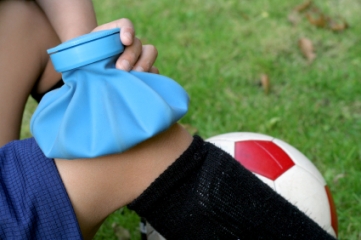Patellofemoral Syndrome is a condition caused by an abnormal tracking of the patella (knee cap) relative to the joint, which can causing pain, ranging from an irritating ache to severe pain while walking to excruciating pain climbing stairs. Wider hips, more joint laxity, and hormonal forces affecting knee position make female athletes more prone to Patellofemoral Syndrome than males.
Left untreated, the nagging pain progresses into a swollen, irritated joint.
Exercises help
Physical therapy can decrease pain, improve knee tracking, and strengthen supporting musculature to reduce future occurrence of Patellofemoral Syndrome. Common techniques include:
- Quadriceps strengthening (particularly VMO – quad muscles closet to the inside of knee joint)
- Hip abductor and external rotator strengthening
- Electrical stimulation ("e-stim"), ice, and manual treatment to address localized knee pain

- Single leg balance exercises
- Examination of feet to determine if orthotics or other corrective exercises are necessary.
Strengthening hip abductors and external rotators key
The strengthening of hip abductors and external rotators is a very important, and often unappreciated, aspect of treating patellofemoral syndrome because they work together to prevent the knee from pronating (turning inward). Watch any young athlete stand on a single leg and commonly the knee cap will face more inward. This position causes the knee cap to track more laterally, aggravating patellofemoral symptoms.
By isolating these two muscles groups with specific exercises, studies have found that athletes experience significant strength increases and decreased reports of pain compared to control groups at the same time the control group experienced a gradual weakening of all muscles groups over the course of 8 weeks. The study thus suggests that, without appropriate rehabilitation, an athlete with Patellofemoral Syndrome will steadily progress towards a more debilitated knee joint.
Talk to your child's doctor first
Talk with your doctor to make sure that your athlete is actually experiencing patellofemoral symptoms. If she is, the doctor can prescribe an appropriate progression of exercises to be administered by a licensed physical therapist to improve strength and decrease pain.
Khayambashi K, Mohammadkhani Z, Ghaznavi K. et al. The Effects of Isolated Hip Abductor and External Rotator Muscle Strengthening on Pain, Health Status, and Hip Strength in Females with Patellofemoral Pain: A Randomized Controlled Trial. Journal of Orthopedic and Sports Physical Therapy. 2012;42 (1):22-29.
Updated September 26, 2012








